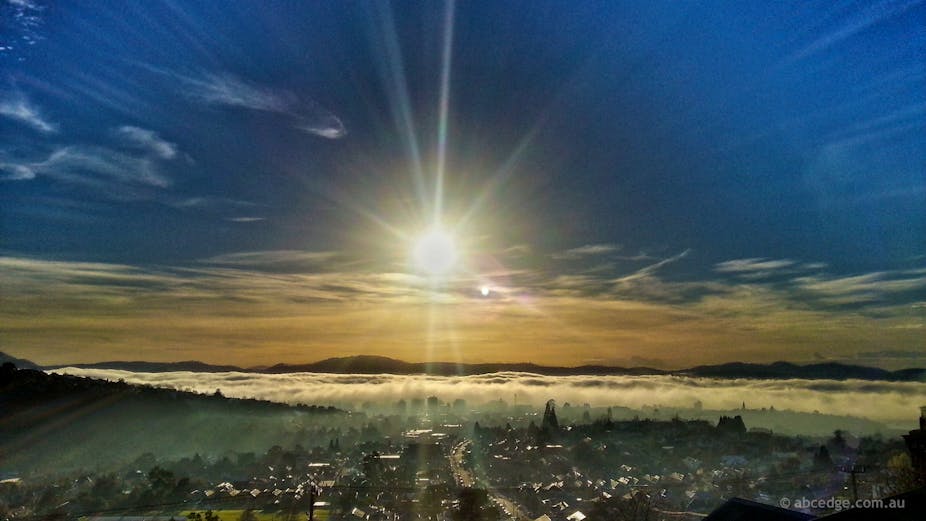At Dark MOFO last week, the City of Hobart joined forces with the Museum of Old and New Art (MONA) to commission New York artist/ landscape architect Vito Acconci to create an architectural prototype for bridging connections between previously discrete aspects of Hobart.
Representatives from the Brooklyn-based Acconci Studio were introduced to six sites. They elected to address ways of connecting Hobart’s city centre to Queens Domain, a large urban park containing 200 hectares including Government House, the Botanical Gardens and significant aboriginal sites – as well as the Hobart Cenotaph (the state’s war memorial) and the Soldiers Memorial Avenue, which have been disconnected by major highways (below).
Acconci Studio’s scheme is more a provocation than a proposal; it’s an idea about an idea for a “bridge” which is not necessarily intended to be built. Still, it can help us understand how to connect places in a city in a manner that transcends a purely pragmatic economic engineering solution.

The changing face of Hobart
In a place that has endured ongoing economic recession, where change has been generally been understood as negative or reductive, the locals can be very resistant to new ideas – even when they may lead to exciting new opportunities.
This has been the case in Tasmania, which has been in a recession since apple exports fell dramatically in the 1970s and other industries of hydro, mining and forestry declined in production and/or employment.
But in the year 2000 the tide began to change. A shift in the property markets occurred as interstate investors began to realise you could buy a house in Tasmania for less than the price of an outhouse in a suburban backyard on the mainland. “Economic refugees” began to arrive in droves. They had turned the tide on ongoing outward migration by 2003.

An influx of people has led to an increase in opportunities – and the state is beginning to find ways to imagine a new future via strategic initiatives for arts and culture. Over the last five years MONA has been transforming the life of the city.
Two years before the museum opened in 2011, MONA launched the inaugural Festival of Music and Art (MONA FOMA, or MOFO for short). Since then MONA has been showing the city how it can be transformed into a place of vibrant life, bolstering tourism while providing a fantastic series of cultural events for the locals.
The City of Hobart capitalised on the positive response to MOFO, developing a strategic initiative for arts and culture, Creative Hobart, which highlights the potential for the city as a “platform for cultural expression and creative participation”.
This included commissioning Acconci Studio to provide speculative ideas for the city.
So, how does Acconci’s proposal stack up?
Acconci’s design proposition is based on the aspiration to “free or liberate persons”, creating multiple choices through walkways leading in different directions. This provides a matrix of discovery in which, according to design notes, the lines of history “wind and wave, you can’t see them all at once but you know they’re there”.
The mesh-like bridge (below) provides a labyrinthine crucible that takes people across the highway. It is complemented by a structured landscape of lights and trees that arc around the cenotaph, providing a contrast to its linear formality.
Acconci’s project is an enticement to think laterally about pragmatic issues of city design. This is beautifully described in a poem by Maria Acconci, which suggests a direct poetic connection between the Cenotaph and the bridge and highlights ideas of memory and experience.

Unfortunately, the main way that the public was able to access these ideas was via a public forum and exhibition presented during Dark MOFO last week. Both of these options offered an abstract and obtuse introduction to the project – and failed to communicate the potential of Acconci’s proposal or provide an understanding of his approach or previous work.
On reflection, one wonders if it’s necessary to build a physical bridge over the road. In reality this would alter the approach into the city, as the dimension of a bridge needed to span the six-lane highway would create a large structure that would mask the broad landscape vista towards Mt Wellington, a key characteristic of the approach to the city.
Perhaps the basket-like structure could take form on an adjacent site, spanning between the Domain and the nearby aquatic centre, providing a lookout back towards the Cenotaph. This would highlight the connections made by the lines of light and trees inscribed within the Cenotaph site.
The physical connection between the Domain and the Cenotaph could be made on the ground, linking under the highway in a manner that extends the picturesque movement that currently characterises the site.
It’s not clear how far this project has been developed in terms of the formal commissioning. Currently Acconci Studio’s project is just the beginning, a thread of an idea. It could take many forms or simply act to inspire broader conceptual approaches to understanding how to shape the city in a way that celebrates place, both from the past and present, as well as into the future.

